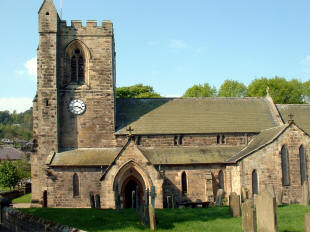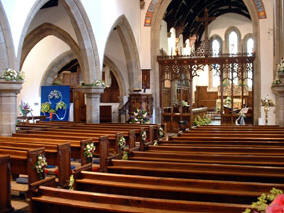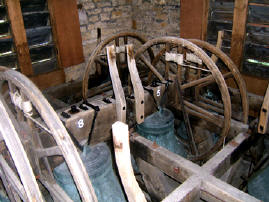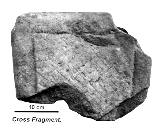|
All Saints Parish Church. All Saints Parish Church is
an ancient place of worship with the Gospel having been preached here
for some 1,200 years. The Anglo-Saxons had a royal burgh here and the
existence of the Anglican cross and evidence of a monastic building to the
west of
It is thought that the monastic church may have been destroyed by Vikings or possibly Normans; but the eastern part seems to have survived to become the foundation of a new building in the 13th century, part of which can still be seen in the chancel, the chancel arch and the east walls of the transepts. The earliest record of the church is when Henry I confirmed that it had been given to the Monastery of Tynemouth by the Earl of Mowbray in 1090 In the 18th century the church had galleries, dormer windows and a three-decker pulpit. But in 1850 when Rector, Canon C. Vernon Harcourt undertook the renovation, these disappeared, and apart from a few additions and minor decorative alterations the church remains very much as we see it today. In 1901 a
carved oak pulpit, choir stalls and chancel screen
were added. The pulpit
was erected "in affectionate
memory of Margaret, wife of Baron Armstrong of Cragside, who died on
In the early 50's the pulpit was moved from its normal position, on the right facing the altar, to the other side as shown in the photo. Today no-one is quite sure why this was done as it now obscures two memorial plaques. On the oaken screen that divides the chancel from the vestry may be seen panels with the coats of arms of twelve of the Rothbury rectors. The vestries themselves are built upon the site of the old Cartington chantry in 1886. This chantry had fallen into decay over the years and in 1658 was blocked up to keep out the elements and other undesirables. The eagle lectern was given in memory of Dr Ainger, rector from 1871-1886 whilst the reredos behind the altar was erected in memory of his third son, Herbert Ainger. One of the greatest treasures in the church is the pedestal of the font. Although the font bowl is dated 1664, replacing the one damaged in the Civil War the pedestal is Anglo-Saxon. Remnants of the old Anglo Saxon cross were found during the 1850 restoration and are now housed in the Museum of Antiquities in Newcastle. Explanatory pictures are displayed in the Baptistry. The carving of the ascension is quoted as the earliest depiction of this subject in England. Nearby, in the corner stands a small bell inscribed 'John Thomlinson Rector of Rothbury, 1682' which hung in the tower till it was replaced in 1893 by the present peal of eight bells.These are tenor weight 13 cwts and carry their individual casting marks and dedication. Mounted in the original oak frame with the joiner's assembly marks clearly visible, these were presented to All Saints' by Mary Dawson "..in affectionate remembrance of the late William Dawson .......". It is worth noting that Mary Dawson was not a resident of Rothbury although her late brother had been and it was her way of ensuring that he would not be forgotten whilst also benefiting the Rothbury community. The new
bells, frame, belfry and ringing room were all built and installed between
Christmas 1892 and Easter 1893 when they were dedicated by the Bishop of
Newcastle and rung by an invited band of ringers from Newcastle The original Bell Ringers Guild Record Book is still in use, containing details of accounts and events since 1893. In 1740 a public clock was placed in the tower of Rothbury Parish Church. There is no record of how, or in what manner funds were raised for its purchase , but in the Church-wardens' accounts there occur entries extending from 1740 to 1818, relating to its erection, repairs, “ winding up," etc. The last-entry in the records regarding the Church Clock is at the Easter Meeting of 1818 and soon after this it appears to have fallen into disrepair. Old Walter Mavin, the Coquet angler, who was born in 1815, told Dippie Dixon that he could not remember the Church Clock ever going during his lifetime, and that as far back as he can recollect the works were all red rust. In 1897 the current tower clock, was erected by public subscription and on 27th June it was set in motion for the first time by Lord Armstrong's son, William. It is not certain when the maintenance of the clock passed into the hands of the Parish Council but in the past few years a number of attempts were made to ensure its accuracy. It seemed to be a major discussion point at PC meetings. In 2012 the responsibility for maintenance was returned to All Saints with the Parish Council still responsible for costs. To the south of the altar is the original 13th century Piscina, where the priest washes his fingers prior to consecration in the Communion Service. For a panoramic view of the Church it is worth visiting http://www.peterloud.co.uk/photos/Northumberland/Rothbury/Rothbury_Church.html to take a virtual trip around the inside. This in turn leads on to a host of other local churches, all of which are worth visiting. On the southern outside wall of the Chancel can be found the remains of two scratch sundials and on the south lawn is a block sundial with four dials, formerly on the roof of the porch. When the provision of a disabled toilet in the church were finally approved and work begun in 2006 archaeologists were commissioned to undertake a watching brief. As a result Dr Ian J Stewart who was present stated that observed results disproved the results of a dowsing carried out by Mr H.D. Briggs in 1988. Mr Briggs' work had indicated that foundations of the preConquest / medieval church extended beyond the limits of the present church and beneath Church Street. However careful examination of the sewer pipe trench that cut through this area revealed no evidence of walls, foundations, construction trenches or suchlike. Dr Stewart suggested that the dowsing had in fact picked up utility pipes and that it is likely that any earlier foundations actually lie beneath the present church. But as the earlier dowsing had indicated foundations much in the style of other mediaeval churches this has not yet been fully resolved. The most significant archaeological feature encountered, was a medieval lime kiln. Residues from the last firing had been re-deposited back in the kiln along with demolition rubble from the kiln. Within the rubble backfill was a small architectural fragment, - bevelled along one edge with traces of lime plaster and paint, of uncertain date.
Yet another important discovery turned out to be a reused fragment of pre-conquest cross arm incorporated into the wall of the kiln. It may be that the original cross was actually fabricated in Rothbury and this fragment may have been part of an earlier work. For a more detailed and comprehensive history of All Saints' please pay us a visit. Look at the graves near the front of the sundials. Three are carved out of slate; memorials to the 'Dore family', slaters by trade, with a thriving business following the demise of thatched roofs. Did you know that from early times England was noted for her wool products and home grown wool was an important part of the national wealth. During the 14th and 15th centuries the protection of this national product was of great importance, and an act was passed in the reign of Charles II for the express purpose of increasing the consumption of English wool. It was decreed that: "No corps should be buried in anything other than what is made of sheep's wool only; or put into any coffin lined or faced with any material but sheep's wool, on pain of forfeiture of £5." The following transcripts (although not unique) were found in the Rothbury Parish Register. "Elizab. Litster, Late of Low Trewitt, deceased, ye 2nd daughter of Edward Litser was buried in nothing but wooling accordyng to ye Act on ye behalf, as does appear by ye affidavit made by Edward Litster and John Vint to Mr. Thom. Collingwood, one of his Majs. Justice of ye Peace, and his certificate under his hand bearing date ye 2nd of 7br., 1678." "Mary Storrey, of ye Craghead, was wrapt or wound up in nothing but woollen accdng to Stat. on ye behalfe, as appears by Affidavit made by Robt. Storry, ibid, to r. Thom. Hursley, in his certificate under his hand, bearing date ye 5th day 5br., 1678" Other interesting graves are to be found across the street in the Closed Grave Yard which actually actually consists of two parts: the upper and lower plots. The lower plot, accessed via steps from the upper graveyard, was first used in 1900 as the burial place of the 1st Lord Armstrong of Cragside. In later years other members of the Armstrong family were buried in this area including the 1st and 2nd Barons Armstrong of Bamburgh and Cragside, their wives and General Sir John Ayde who died in 1900 aged 80. He fought in both the Crimean War and the Indian Mutiny and was credited with putting down the Egyptian rebellion of Arabi Pasha. He later became the Governor of Gibraltar. This area is separated from the remainder of the lower graveyard by iron railings and an entrance gate. Or, at least, was. The railings separating both areas were removed as part of the war effort and the gates finally removed in 2005. Whilst the Armstrong plot was supposed to be the responsibility of the Armstrong Estate it is now maintained on a voluntary basis by a retired local. The outer plot and the other closed graveyards are the responsibility of the local council. Both are now in good repair. It is worth noting that it was once suggested that sheep be used to keep the grass in check and reduce maintenance costs but this idea fell on stony ground along with other ideas of creating a small park although there is now an information board and a few seats where you can rest and meditate. Maybe even pen a modern Gray's Elegy. There is a beautiful headstone in the lower graveyard erected to the memory of Walter Mavin, The Coquet Angler. Walter was born in 1814 and died in 1900 and was reputed to have trained Lord Armstrong in the arts of fishing. The stone shows a mountain stream, with a kingfisher on a rock whilst on the bank are a fishing rod, creel and fish. The inscription reads: "But where's the auld
fisher, sae bent and sae lame, Local lore says
that Rothbury Castle stood here, overlooking the River Coquet. No trace
remains today although, in a sketch published by Dippie Dixon, Rothbury Hall
can be seen and it is thought that with its square tower but no
crenellations this building may have been the castle. In
an old photograph circa 1843 there appears to a tower peeking over the sides of
houses in that area. Mr J. Reynaulds is credited with identifying this.
Part of the hall was in use till the middle 1800s but when the church yard was extended in 1869 it was finally demolished and its foundations removed. Next door to the church is the Parish Hall |



